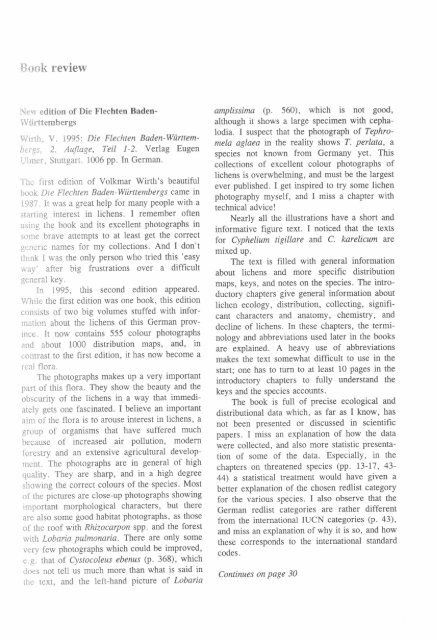GMPHIS SCRIPTA - Universitetet i Oslo
GMPHIS SCRIPTA - Universitetet i Oslo
GMPHIS SCRIPTA - Universitetet i Oslo
Create successful ePaper yourself
Turn your PDF publications into a flip-book with our unique Google optimized e-Paper software.
Rqrclk review<br />
it{erv edition of Die Flechten BadeniV,i.xrttembergs<br />
Wirth, V. i995 Die Flechten Baden-Wtirttemfsergs,2.<br />
Auflage, Teil I-2. Verlag Eugen<br />
Ulrner, Stuttgart. 1006 pp. In German.<br />
Thc first edition of Volkmar Wirth's beautiful<br />
bock Die Flechten Baden-Wiirttembergs came in<br />
t987. It was a great help for many people with a<br />
starting interest in lichens. I remember often<br />
using the book and its excellent photographs in<br />
some brave attempts to at least get the correct<br />
gelieric names for my collections. And I don't<br />
tiiink tr was the only person who tried this 'easy<br />
n,f,y' after big frustrations over a difficult<br />
geiieral key.<br />
In 1995, this second edition appeared.<br />
Vihiie the first edition was one book, this edition<br />
ccnsists of two big volumes stuffed with inforrnation<br />
about the lichens of this German province.<br />
It now contains 555 colour photographs<br />
and about 1000 distribution maps, ffid, in<br />
ccntrast to the first edition, it has now become a<br />
r*al flora.<br />
The photographs makes up a very important<br />
part of this flora. They show the beauty and the<br />
obscurity of the lichens in a way that immediately<br />
gets one fascinated. I believe an important<br />
airn of the flora is to arouse interest in lichens, a<br />
group of organisms that have suffered much<br />
because of increased air pollution, modern<br />
forestry and an extensive agricultural developrnent.<br />
The photographs are in general of high<br />
quality. They are sharp, and in a high degree<br />
showing the correct colours of the species. Most<br />
of the pictures are close-up photographs showing<br />
important morphological characters, but there<br />
are also some good habitat photographs, as those<br />
of tho roof with Rhizocafpon spp. and the forest<br />
with Lobaria pulmonaria. There are only some<br />
very few photographs which could be improved,<br />
e"g" that of Clstocoleus ebenus (p. 368), which<br />
does not tell us much more than what is said in<br />
rhe text, and the left-hand picture of Lobaria<br />
amplissima (p. 560), which is not good,<br />
although it shows a large specimen with cephalodia.<br />
I suspect that the photograph of Tephromela<br />
aglaea in the reality shows T. perlata, a<br />
species not known from Germany yet. This<br />
collections of excellent colour photographs of<br />
lichens is overwhelming, ild must be the largest<br />
ever published. I get inspired to try some lichen<br />
photography myself, and I miss a chapter with<br />
technical advice !<br />
Nearly all the illustrations have a short and<br />
informative figure text. I noticed that the texts<br />
for C)phelium tigillare and C. karelicum are<br />
mixed up.<br />
The text is filled with general information<br />
about lichens and more specific distribution<br />
maps, keys, and notes on the species. The introductory<br />
chapters give general information about<br />
lichen ecology, distribution, collecting, significant<br />
characters and anatomy, chemistry, and<br />
decline of lichens. In these chapters, the terminology<br />
and abbreviations used later in the books<br />
are explained. A heavy use of abbreviations<br />
makes the text somewhat difficult to use in the<br />
start; one has to turn to at least 10 pages in the<br />
introductory chapters to fully understand the<br />
keys and the species accounts.<br />
The book is full of precise ecological and<br />
distributional data which, as far as I know, has<br />
not been presented or discussed in scientific<br />
papers. I miss an explanation of how the data<br />
were collected, and also more statistic presentation<br />
of some of the data. Especially, in the<br />
chapters on threatened species (pp. I3-L7 , 43-<br />
44) a statistical treatment would have given a<br />
better explanation of the chosen redlist category<br />
for the various species. I also observe that the<br />
German redlist categories ate rather different<br />
from the international IUCN categories (p. 43),<br />
and miss an explanation of why it is so, and how<br />
these corresponds to the international standard<br />
codes.<br />
Continues on page 30

















